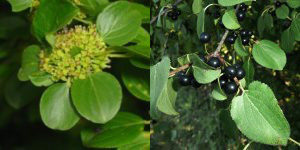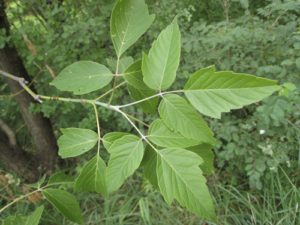Common Buckthorn (Rhamnus cathartica)

Rhamnus cathartica also known as European Buckthorn invades forests, prairies, and savannas and can form dense thickets crowding out native shrubs and understory plants. It is difficult to remove and can regenerate after cutting or burning. It is a native of Europe and was introduced into North America as an ornamental shrub.
Habitat
- open areas, disturbed forest edges, ravines, forests, thickets, wetlands
- will germinate in sun or shade
- shade tolerant under forest canopy
Reproduction and dispersal
- prolific seed production, seed dispersed by birds
- produces seed at a very young age
- root suckers, re-sprouts vigorously from cut stumps
- forms a consistent seed bank, seed can remain viable 2 – 3 years
What can you do?
- report any sightings with location and picture (if possible)
Tatarian Honeysuckle (lonicera tatarica)

Lonicera tatarica readily invades open woodlands, old fields, and other disturbed sites. It can spread rapidly due to birds and mammals dispersing the seeds and can form an extremely dense understory thicket which can restrict native plant growth and tree seedling establishment. This plant is a native of eastern Asia and was first introduced into North America as an ornamental in 1752.
Habitat
- disturbed areas, wetlands, woodland edges, woodlands
- moderately shade tolerant, canopy gaps
Reproduction and dispersal
- prolific seed production, berries highly attractive to birds, which disperse seeds widely
- seed remains viable 4-5 years
- sprouting occures in established populations
What can you do?
- report any sightings with location and picture (if possible)
Dog Strangling Vine (Cynanchum rossicum)

The Dog Strangling Vine which is a member of the Milkweed family and can deceive the already stressed Monarch Butterfly into laying eggs on a plant that its larva cannot digest.
Habitat
- fields, hydro corridors, disturbed forest edges, ravines
- not tolerant of heavy shade, but is capable of transforming healthy forest over time into more open woodlands
Reproduction and dispersal
- prolific seed production, seed wind dispersed over long distances
- able to regenerate from root crown pieces
What can you do?
- report any sightings with location and picture (if possible)
- limit travel through areas infested with Dog Strangling Vine during seed dispersal to prevent spreading
- take the time to remove seeds from boots, clothes, pets, bicycles, etc…
Garlic Mustard (Alliaria petiolata)

Garlic Mustard has a known allelopathic effects that prevent the successful germination and growth of native species
Habitat
- river flood plains, forests, roadsides, wooded edges and forest openings
- tolerates full sun and full shade (prefers partial canopy)
- one of a few non natives that dominate the understory of forested areas
Reproduction and dispersal
- biennial, a rosette of leaves formed during 1st half of 2 year cycle
- in 2nd spring, rosette developes rapidly into mature plants that flower, produce seed and die by late June
- a single plant can produce thousands of seeds that scatter as much as several meters from the parent plant
- long distance dispersal is most likely aided by human and wildlife (deer)
- spreads rapidly, can displace native plants within 10 years of becoming established
What can you do?
- report any sightings with location and picture (if possible)
- pull or break off plants at time of flowering prior to seed pod development (early May). Remove stems as pulled flower stems can still form viable seeds if left lying on the ground. Revisit site several times to remove any new plants
Common Reed (Phragmites australis

Phragmites has known allelopathic effects on other wetland plants that prevent the successful germination and growth of native species
Habitat
- readily invades open wetlands, especially those with disturbances
- Reproduction and dispersal
- produces wind-borne seeds, but moves most rapidly through a stoloniferous root system
What can you do?
- report any sightings with location and picture (if possible)
- only pull if you are sure you can remove entire root system
Manitoba maple (Acer negundo)

The Manitoba Maple is a native of the Canadian Prairie and the US Mid-west with a range south the Texas. This rapid growing tree now commonly found in Southern Ontario where it has spread from horticultural uses to natural areas. Where it takes hold it can dominate the lower tree canopy and almost totally stop the regeneration of species native to our area.
Habitat
- disturbed woods, (often floodplains), roadsides, pastures, yards
- tolerant of poor soils
Reproduction and dispersal
- produces winged seeds that are widely dispersed
- seeds germinate readily and seedlings grow rapidly forming monoculture woodlands
What can you do?
- report any sightings with location and picture (if possible)
- pull young seedlings and plants